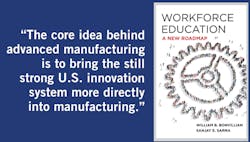William B. Bonvillian and Sanjay E. Sarma’s book Workforce Education: A New Roadmap gives a vast background of manufacturing job growth and loss through the centuries, and the forces behind the changes. It examines current workforce education programs and what makes them successful. And it envisions the future of industry as it relates to recruiting new and retaining incumbent talent.
Looking for other great content to read? Reliable Reading will review stellar books on the maintenance and reliability industry, leadership and management practices, and anything that relates to professionals in our industry.
The following are some of my major takeaways for manufacturing and its new workforce education, but you’ll likely find much more on your own in this encyclopedia of workforce history and recommendations for developing the needed future technical skills.
Manufacturing drives the U.S. economy
Between 2000 and 2010, manufacturing lost one-third of its jobs, driven largely by international competition. By 2017, 17% of those jobs had returned, but the following year, manufacturing output remained 4.7% below 2007 pre-recession levels. “The low productivity level signals an underlying innovation system problem,” Bonvillian and Sarma say.
Tracking manufacturing jobs and productivity matters because historically manufacturing drives the U.S. economy. Similarly, manufacturing is the largest job multiplier, so those job losses (or potential gains) also reverberate through other sectors.
“Manufacturing has long been understood as the economy’s largest job multiplier: manufacturing processes raise demand for raw materials, energy, construction, and services from a wide range of supplier industries,” Bonvillian and Sarma say. “Manufacturing’s effects on the economy are even greater when the entire manufacturing value chain plus manufacturing for other industries’ supply chains are taken into account; manufacturing could account for one-third of GDP and employment.”
Workforce education is lacking a system
In many cases, workforce education is thriving in local pockets at community college, at federal institutions, and at individual employers. Those that have pushed hard for a locally trained workforce often reap the benefits, but the overall system cannot grow at that rate, the authors argue. They suggest that there is a growing disconnect between work and school. In general, industry is not informing what should be taught, and education is not preparing workers with the right technical skills. In addition to feeding new entrants into the workforce, incumbent workers also need access to continuing education to keep up with technological advances.
“Our education system is not ready to prepare our workforce for the rapid rate of technology advancement led by information technologies,” the authors say. Between 1996 and 2008, the percentage of workers that received employer training dropped from 20 to 11 percent, and individual employers that plan education opportunities rarely pool resources.
“There are few incentives to collaborate, and this gap in collective activity amounts to a market failure. What is lacking is a system,” Bonvillian and Sarma argue. “If the United States is to move into advanced manufacturing, there is no effective system at present for educating the workforce in the advanced skills it requires.”
U.S. industry needs manufacturing-led innovation
Disconnection also exists between innovation and production. “While the United States relies on entrepreneurial start-ups with venture capital financing to bring innovation into the economy, venture capital is focused increasingly on returns from software, service, and biotech. ‘Hardtech’ firms that planned to manufacture received only 5 percent of venture funding investments in 2015 and thus are effectively being blocked from scaling their innovations,” Bonvillian and Sarma say.
In the U.S., R&D is the source of innovation, not manufacturing. “But innovation is a system, from R&D through production stages, and the failure to understand production as a key part of that system is a fragmented view,” Bonvillian and Sarma explain. “If the United States wants to keep pioneering new technologies, we will also need manufacturing strength. A strong innovation system is crucial to the U.S. advanced economy; a technology strategy disconnected from manufacturing advances leads to a broken innovation system.”
Countries like Germany, Japan, Korea, Taiwan, and China have manufacturing-led innovation. New advanced manufacturing paradigms (digital production, advanced materials, nanomanufacturing, mass customization and energy efficiency) demand it.
How authentic leadership can help drive business results
A good leader is an organized leader
How to utilize checklists to improve your maintenance program
“The core idea behind advanced manufacturing, then, is to bring the still strong U.S. innovation system more directly into manufacturing. This, in turn, will require new advanced workforce skills and corresponding training,” the authors explain. “A system is needed in which a connected network of firms, universities, labor, governments, and national and corporate labs together nurture the next generation of production technologies, processes, and education infrastructure.”
The labor market system is broken
This network of connected systems for workforce development is also broken. “Workers and employers alike are largely flying blind,” Bonvillian and Sarma say. Many different agencies collect relevant workforce data, but they serve the public independently. Bringing those resources together may serve as a starting point.
Workforce and labor data is primarily managed by several federal agencies: the Bureau of Labor Statistics and the Employment and Training Administration in the Department of Labor; the Census Bureau in the Commerce Department, and the National Center for Education Statistics in the Department of Education. Another larger group of agencies also collect relevant data.
“It’s a mess; but suppose we had a navigation system. There could be online-delivered interventions to help workers facing job dead ends find work opportunities requiring skills adjacent to their own that they could master,” Bonvillian and Sarma say.
Some work has been done to bring all this data into one usable system. “This rich lode of government data could provide a base for an operating information system that potentially could be complemented by employer and educator data,” the authors say. “Overall, to be an efficient system—the invisible hand to work—this system must operate at a large scale.”
Online, on-demand technologies can scale
In many cases, the pandemic sped up the adoption of remote or online work, school and more. For many younger students, it highlighted the importance of face-to-face interaction, but for industry it accelerated an already trending investment in remote capability and digitally-connected facilities.
The groundwork for this has been laid for quite some time. In the 2010s, Massive Open Online Courses (MOOCs) became widespread and have greatly influenced training. This type of education technology, or edtech, combines a short video format with computer grading, and online forums for students to interact with teachers. Humans are wired to learn in 10-minute chunks; after that, we’re essentially prone to zoning out, according to the authors. “YouTube is probably the most important edtech platform out there,” the authors say.
There are many emerging forms of edtech—automatic lecture capture, AI grading and testing, intelligent tutoring systems (ITS), which teach by modeling to the student, simulations and more. Industry is already using many of these tools – artificial intelligence, machine learning, AR/VR and simulations, which are making strides as edtech too. It’s a natural partnership for industry education. In addition, these types of learning formats, the authors argue, are geared toward learning by doing or hands-on learning, which is suited to industry technical training needs.
“These online, on-demand technologies hold great promise for education and for workforce education in particular. Unlike, a classroom, they can operate at a great scale,” the authors say. With AI, the potential is that systems can guide and personally adapt training for individual students, at scale. “With a workforce of more than 150 million people requiring systematic upskilling and lifelong learning, and a problematic existing delivery system, it is difficult to envision how to provide this access without extensive use of the scaling possibilities of online education,” Bonvillian and Sarma say.
Soft skills are important
Even for industrial environments, researchers suggest that social skills, among other soft skills, are important for today’s workforce. Bonvillian and Sarma outline many definitions of this elusive skill. The National Network of Business and Industry describe personal skills (integrity, initiative, dependability and reliability, adaptability, and professionalism); and people skills (teamwork, communication, and respect). The Center for Third Space Thinking at the University of Southern California have identified five core soft skills—adaptability, cultural competency, empathy, intellectual curiosity and 360-degree thinking. “The labor market increasingly rewards social skills; with more and more jobs requiring high levels of social interaction as team production expands, workers rely on each other, and employers need workers that can adapt flexibly to workplace changes, including the ability to trade jobs and tasks,” the authors say.
This story originally appeared in the May 2022 issue of Plant Services. Subscribe to Plant Services here.
About the Author

Anna Townshend
managing editor
Anna Townshend has been a journalist and editor for almost 20 years. She joined Control Design and Plant Services as managing editor in June 2020. Previously, for more than 10 years, she was the editor of Marina Dock Age and International Dredging Review. In addition to writing and editing thousands of articles in her career, she has been an active speaker on industry panels and presentations, as well as host for the Tool Belt and Control Intelligence podcasts. Email her at [email protected].

